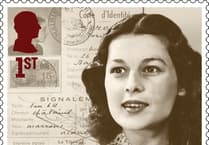A FRAGMENT of a letter found inside a 400-year-old book at Hereford Cathedral could throw a completely new light on William Shakespeare's relationship with his wife Anne Hathaway.
For centuries, it has been assumed that they largely lived separate lives after the playwright found fame and fortune in London.
But new analysis of the letter addressed to a ‘Mrs Shakespeare’ at a London address suggests that Shakespeare did not simply leave his wife behind in Stratford, and they had lived together for some of the time in the city.

The intriguing letter is 'manuscript waste' which used in the binding of a copy of Johann Piscator’s Analysis logica omnium epistolarum Pauli published in 1608, when Shakespeare was at the peak of his powers in the capital, having just written Macbeth, King Lear and Antony and Cleopatra.
The book was printed by Richard Field, a known associate of William Shakespeare, and is currently held in the library of the cathedral on deposit as part of a larger collection from the Lady Hawkins School in Kington.
The existence of the letter was first reported 1978 by FC Morgan, then honorary librarian of the Cathedral, before being shared by the then librarian Dr Rosemary Firman who put out an appeal, inviting people to help solve the puzzle with their own research.

The letter was also displayed in the Mappa Mundi and Chained Library to mark the 400th anniversary of Shakespeare’s death.
But new research by English professor Dr Matthew Steggle of Bristol University, indicates that there is in fact a link to the Shakespeare family within the letter.
He uses contemporary archival research techniques to uncover a fascinating story which would put a fresh perspective on Anne Hathaway’s role in Shakespeare’s business affairs.
Traditionally being seen as being left behind in Stratford, and only left his 'second-best bed' in Shakespeare's will, Anne has been potrayed as the unhappy wife.
But Bristol University says Professor Steggle's examination of the fragment, addressed to “good Mrs Shakespeare”, appears to show both of them living together in central London at some point in the decade 1600-1610.
In the letter, Shakespeare is allegedly withholding money from an orphan apprentice named John Butts, and someone has written to Mrs Shakespeare asking her for money for the boy.
Mrs Shakespeare stands by her husband, telling the letter-writer that it's their problem to find the money.
Prof Steggle said: “First discovered in 1978, the letter’s been known for a while, but no-one could identify the names or places involved, or see any reason to think that the Mr Shakespeare in the letter was necessarily William, rather than anyone else of the same name in the general period.
“So, it’s a story about the Shakespeares’ marriage, really, as well as about Shakespeare’s London contacts. And if the writing of the back of the letter is a reply, then it’s also a story about the first ever bit of writing which can be attributed to Anne Hathaway.”
Prof Steggle discovered that John Butts finished his apprenticeship in 1607 and had lived in the area of 'Trinity Lane' where a 'Mr Shakspaire' also lived, close to Richard Field's printing shop.
“In short – it's two steps. You identify the boy involved and given that it's him and that fixes the date, then Shakespeare is much the best recorded candidate to be the London-based “Mr Shakspaire”,” he added.
“It at least doubles the number of letters known to be addressed to or sent from Shakespeare and his family. Currently, there's only one known.
“It also shows a side of Shakespeare's London life that's not been known before, giving him a new address in Trinity Lane and a whole new sphere of activity for him.
“Since this letter is the first reference of any sort to Anne Shakespeare in London, and since the absence hitherto of any such references is the mainstay of the argument that she was entirely based in Stratford, it opens the door to considering the possibility that she did indeed spend significant time with her husband in London.
“And it seems to show her being involved with her husband's money affairs and social networks. So, it's a game-changer in terms of thinking about the Shakespeares' marriage.
"And, if the material on the back is (as it may well be) a fragment of a reply from Mrs Shakspaire, then these would be the first recorded words ever to have come from Shakespeare's wife.”
Jennifer Dumbelton, Librarian at Hereford Cathedral, said: “The mystery of these letters has been circulating for decades, so it’s thrilling to see Dr Steggle’s fresh approach to the problem!
"It’s testament to how small details can make a big difference to our understanding of history when closely analysed through different lenses like those offered by humanities studies. The Lady Hawkins School collection is a gem, and we’re lucky to hold it at the cathedral.”
The letter is not currently available to view within Hereford Cathedral, but discussions are underway on how best to exhibit or share the document in the coming months.


.jpeg?width=209&height=140&crop=209:145,smart&quality=75)

